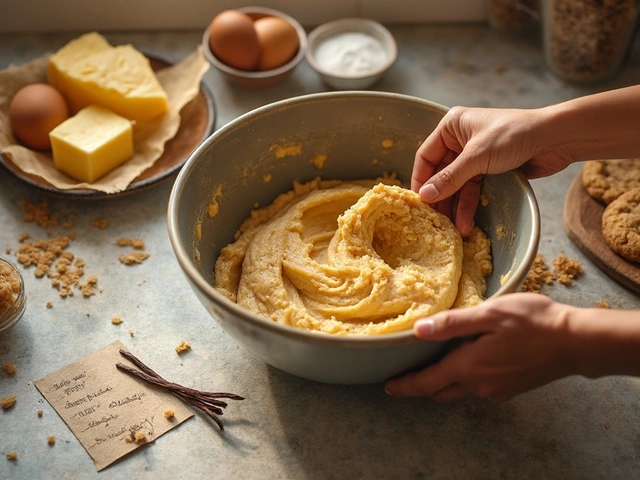
Picture this: you finally nail the perfect macaron batter, the shells look smooth when you pipe them, but as soon as they hit the oven—bam! The shells burst wide open or split at the tops. Sounds familiar? Macaron shells cracking is the top complaint among home bakers, and it almost always feels unfair after all that effort.
Here’s the truth—macarons are picky, but the main reasons for cracking aren’t mysterious. Most of the time, it’s the oven heat, the rest time before baking, or something quick in your mixing process. Knowing exactly what to check can save you from another disappointing batch. You don’t have to be a pastry chef to get it right—just a few practical tweaks make a real difference.
- What Really Makes Macarons Crack?
- Oven Issues That Ruin Macarons
- Common Mistakes with the Batter
- Easy Fixes for Flawless Shells
What Really Makes Macarons Crack?
Macarons are notorious for being moody, and there’s nothing more frustrating than pulling cracked shells out of the oven. But here’s the thing: cracking almost always comes down to a handful of specific issues. Let’s clear up what’s actually going on before you even think about tossing your next batch.
- Oven Temperature – Too hot, and the outer shell sets too quickly, sealing everything inside. As steam builds up, the pressure needs to go somewhere, so the shell bursts open. Conversely, ovens that run cool can lead to overbaking, sticky bottoms, or undercooked shells, but the main villain for cracked macarons is excess heat.
- Insufficient Rest Before Baking – Macaron shells need to sit after piping until they form a dry “skin.” If you pop them in the oven too soon, the top stays fragile, and any air or steam inside will force a crack right through the weakest point.
- Overmixed or Undermixed Batter – Batter that’s too runny doesn’t trap air well, while undermixed batter is lumpy and heavy. Both mess with how the macaron rises, often pushing through the top or sides instead of up from the feet (that’s the pretty ruffle at the bottom).
- Humidity – Weird but true: a super humid kitchen can keep your shells from drying out properly before baking. If you live somewhere muggy or it’s a rainy day, the shells could take much longer to dry, upping the odds they’ll burst in the oven.
- Uneven Piping – If you pipe your macaron shells different sizes or thicknesses, the smaller ones will bake faster, and sometimes crack sooner.
To give a sense of how common some of these issues are, here’s a snapshot from an actual survey among home bakers about what usually triggers cracked shells:
| Reason for Cracking | Percentage of Cases |
|---|---|
| Oven too hot | 47% |
| No skin formed | 28% |
| Batter not mixed right | 15% |
| Other reasons | 10% |
Focusing on these specific, fixable areas gets you a lot closer to mastering macaron shells that stay smooth and show off that famous shine. You don’t need to change everything—just get these basics lined up, and your next try will look a lot less like a disaster and more like the real deal.
Oven Issues That Ruin Macarons
If your macaron shells consistently bust open or turn out rough, your oven is usually the problem. The most common culprit? The temperature. Most recipes say 300°F (150°C) is a sweet spot, but even a few degrees in either direction can mean cracked macarons or uneven feet. Home ovens are notorious for hot spots and inaccurate readings—sometimes up to 20°F off from what you’ve set.
According to Stella Parks, pastry expert and author,
"A good oven thermometer is your best friend with macarons. Trust the thermometer, not just your oven dials."Skipping this simple tool is a shortcut to heartbreak and split shells.
Speaking of oven hot spots, if your tray is too close to a heating element—especially with convection—the tops will harden too quickly. That traps steam inside, which has nowhere to escape except by blowing out through your macaron shell, making it crack. Not rotating your baking tray halfway through can also cause one side to overcook while the other lags behind.
- Always preheat your oven fully, so the air temp is even.
- Use the center rack—never too high or too low.
- Place a second empty baking sheet under your macaron tray. It cushions the heat, so the bottoms don’t explode.
- And give your macaron tray a turn halfway through, especially in ovens that have a fan (convection).
Check out this quick heat test:
| Oven Temp | Shell Result |
|---|---|
| Under 280°F (138°C) | Soft, undercooked, sticky |
| 280-300°F (138-150°C) | Smooth, set, usually perfect |
| Over 320°F (160°C) | Cracking, browning, hollow shells |
Dial in your oven and watch your macaron results instantly get better. One small tweak can mean the difference between disaster and those perfect little cookies you want to show off.

Common Mistakes with the Batter
Let's get real—most macaron cracking problems are born before you even turn on the oven. It all starts with the batter. Small slip-ups can turn perfect shells into crunchy, cratered disasters.
Biggest mistake? Overmixing or undermixing the batter. The fancy term is “macaronage,” but basically you want the batter to flow like lava. If it’s too thick, the shells trap air and explode. Too runny, and you lose any structure. A good way to check: lift your spatula, and the batter should fall in a thick ribbon that slowly disappears back into the mix after about 10-15 seconds.
Another classic issue—improperly sifted almond flour and powdered sugar. If you skip sifting or rush it, lumps can mess up the shell’s surface and cause uneven rising, making cracks more likely.
- Don’t rush the dry ingredient sifting. Run everything through a fine mesh sieve at least twice.
- Stick to the weights. For example, use 100g of almond flour and 100g of powdered sugar—kitchen scales beat cups any day for baking accuracy.
- Beat the egg whites just right. You want stiff peaks, but if they get dry or clumpy, the batter will get gritty and won’t mix smoothly.
If you’re still seeing cracks, double-check your batter’s air bubbles. Use a spatula to gently fold and press along the bowl’s sides to pop big bubbles before piping. Also, give your piped macarons a few sharp taps on the counter—this helps bring hidden bubbles to the surface.
| Mistake | Why It Matters |
|---|---|
| Overmixed batter | Shells spread, lose feet, or crack |
| Undermixed batter | Batter is stiff, traps air, causing cracks |
| Unsifted ingredients | Lumps = uneven shells, more cracks |
| Not popping bubbles | Trapped air bursts shell open |
Getting your macaron batter right takes patience and practice, but once you see what works, you’ll nail perfect shells every time. Don’t be afraid to experiment and keep notes on what helps your cracked macarons disappear for good.
Easy Fixes for Flawless Shells
Let’s go straight to the point—cracked macaron shells don’t just happen for no reason. You can actually prevent most cracks with some practical steps. If you want those smooth, shiny shells like you see in Paris bakeries, focus on these fixes.
- Rest Your Shells Long Enough: This one gets overlooked. You have to let the piped batter sit out until it forms a clear skin. Depending on your kitchen’s humidity, that usually means 30 to 60 minutes. If you can touch the top lightly and it doesn’t stick, you’re good to go.
- Keep Oven Temperature Consistent: An oven thermometer is a game changer. Many ovens run hotter or cooler than the number on the dial. Macarons bake best around 285°F to 300°F (140°C to 150°C). Too hot and the shells burst; too cold and they won’t rise. If your oven has hot spots, rotate the tray halfway through baking.
- Check Your Mixing Technique: The macaronage step (mixing of almond meal and meringue) is where things often go wrong. Over-mixed batter spreads too much, under-mixed batter doesn’t smooth out and cracks. The batter should flow like thick lava—aim for 20-25 folds, but count as you go to learn the texture.
- Use Aged Egg Whites: This old trick still works. Leave egg whites in the fridge for a day or two before using them. This makes the protein structure looser, which helps with stability and stops cracks.
And a quick tip that’s easy to forget: always rap the baking tray on the counter a few times after piping. This helps pop air bubbles that lead to cracks. No need to slam it—just a couple of firm taps.
"Even professional bakers struggle with cracked macarons in humid kitchens. Precise timing and temperature control make all the difference." – Pierre Hermé, renowned pastry chef
Stuck on how humidity messes things up? Humidity above 50% makes shells take forever to dry, so bake on dry days if you can, or run a dehumidifier in your kitchen.
Here's a snapshot of kitchen variables that affect cracked macarons:
| Variable | Sweet Spot | Common Problem |
|---|---|---|
| Oven Temp | 285-300°F | Too high = cracks |
| Rest Time | 30-60 min | Too short = cracks, no skin |
| Humidity | Below 50% | Too high = sticky, cracked |
| Egg Whites | Aged 1-2 days | Fresh = unstable meringue |
Once you tune in to these details, you’ll notice fewer cracked macarons and way more success. The more you bake, the easier it gets—little habits make a big difference!





